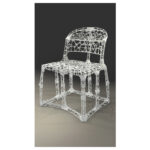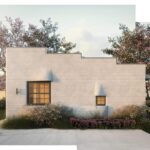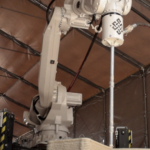ICON, in partnership with Lennar, is close to completing a community of 100 3D-printed homes in Texas. Launched in November 2022, the project is one of the first large-scale endeavors of its kind, with nearly a quarter of the homes already sold and new residents moving in.

The Process Behind the 3D-Printed Homes
The homes in this new neighborhood feature walls constructed by Icon’s Vulcan 3D printer, a machine equipped with a crane-like robotic arm that extrudes concrete layer by layer, much like frosting on a cake. The Vulcan printer is guided by a digital design, which allows it to lay down the precise footprint and gradually build up the walls. While the walls are 3D printed, other aspects of the homes, such as foundations, roofing, and interior finishes, are constructed using traditional methods.

This project showcases some of the advantages of 3D printing in construction. For example, a house can be printed in about three weeks with the Vulcan printer and a single crew. Icon collaborated with the design firm Bjarke Ingels Group to create eight different floor plans for these ranch-style homes, which range from three to four bedrooms and vary in size from 1,574 to 2,112 square feet.

Market Reception and Future Potential
So far, around 25 percent of the homes have been sold, with prices ranging from $450,000 to $600,000, which is on par with other homes in the area. Early buyers have already moved in, and feedback has been positive. One couple noted that their home feels solidly built, with thick concrete walls that provide excellent insulation, keeping the interior cool during Texas’s intense summer heat. The homes also come equipped with solar panels, offering a sustainable energy source. However, the concrete walls do pose a challenge for WiFi signals, requiring residents to use a mesh network for internet connectivity.
The concept of 3D printing homes has been around for over two decades, and companies like Icon have made significant progress in refining the process. This includes improving concrete materials, robotic delivery systems, and determining which construction steps are best suited for 3D printing. While 3D printing is often seen as a more efficient and less resource-intensive way to build, the market prices for these homes have not yet been significantly lower than those built using traditional methods. Some aspects, such as installing windows or other fixtures, may actually increase costs when integrated into unconventional 3D-printed designs.
Looking Ahead: The Future of 3D-Printed Housing
To address cost concerns and further advance 3D-printed housing, Icon launched Initiative 99 in 2023, a competition aimed at designing 3D-printed homes that can be built for under $99,000. The winners of the first phase of this competition were announced at this year’s SXSW.
While 3D printing in commercial homebuilding is still in its early stages, the Texas project represents a significant step forward. As companies like Icon continue to refine the technology and integrate it into the broader construction industry, there is potential for costs to decrease and for 3D printing to become a more common method of building affordable housing.
In the meantime, a select group of Texans will soon be enjoying life in their new, innovative homes—sheltered by the distinctive corduroy-textured concrete walls that set these 3D-printed houses apart from the rest.









